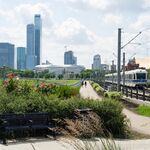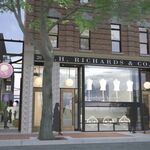The_Cat
Senior Member
If Londonderry ever chooses to build high density residential, this could be a possibility.
An ideal minor expansion of Edmonton's Capital LRT Line would be building one on 66th Street Northwest. The popular Londonderry Mall and neighbourhoods surrounding it would be located within walking distance of rail.
The Capital Line already uses CTC, which includes components like the automatic block signals and powered switches that can be operated from the centralized control center as well as in the field.I agree that doing minor expansions and branches like this could give us a pretty great system! Edmonton has a huge asset that helps us do this, being the downtown tunnel, It's just that at some point (in the near future) the signaling system on this section in particular will have to be switched to CTC instead of fixed block to accommodate all of the trains during peak service. Even with just the Capital and Metro lines my train yesterday had to slow down or even stop several times because (I presume that) it came to a block with a train already in it.
Branches do not equate to streetcars. Both the Canada Line and Expo Line in Vancouver have branches.I don't think what we need are branches off of the Capital Line in the northeast. This isn't a streetcar system.
100% agree. This station should take priority over any other infill stations on the network.It was brought up again on the Valley Line thread, but I think it's worth mentioning again, I think there should be thoughts of building a brand new station just north east of 95st. The station could be similar in scale to most of the Valley Line stations with exception of course of the height of the station. This would serve the area South and Little Italy to the north quite well I think.
The two systems serve different functions. The quasi metro system of the capital line promotes urb sprawl while the low floor urban vehicle system promotes infill and densification.Although I think the City is making some big mistakes with the Valley Line, I have to give them top marks on the Capital Line South expansion. It's being done right, with a tunnel crossing at 23 Avenue. I also like the fact that the design maintains crossing gates at key intersections (like 9 Avenue, just south of the Twin Brooks Station) so that the train is not waiting at traffic lights. I particularly like the elevated station at Ellerslie and the raised guideway across Ellerslie Road for future expansion. Nice to see a proper station is being built at this key point on the line. I also agree with the fact that the City is prioritizing this leg (over the Metro Line extension to Castle Downs) in order to get an additional OMF on the Capital Line.
But can we build a nicer crossing over the Henday than that truss bridge?
Better road access from Clarview LRT for BRT to Londonderry and points West. From Coliseum you would be stuck going on 118th Avenue and up 82 Street and that is traffic intense without wide roadways to create a BRT lanes.I think there might be more express bus options available once the 66 Street Bridge crosses the Yellowhead. and Fort Road is widened. For example, there could be a bus from the Coliseum Station to Londonderry and points in NE Edmonton.
No, the Capital Line does not promote urban sprawl. Remember, LRT lines in Edmonton tend to be built at a snail's pace--the lines to Mill Woods and WEM were promised in the 1980s and will be only 40 years late--and start running LONG after an area is developed. An occasional infill project or two may go up after the train is running, but nothing dramatic. Remember how the LRT at Belvedere was supposed to spark an urban village renaissance along Fort Road? That never happened. And how McKernan-Belgravia station was going to lead landowners to demolish all the nearby homes and build apartment condos? That also never happened. Even Century Park is taking forever to complete and the train has been running for 12 years.The two systems serve different functions. The quasi metro system of the capital line promotes urb sprawl while the low floor urban vehicle system promotes infill and densification.
I don't see how you're contradicting them here. The Capital Line primarily functions as a funnel from the suburbs to downtown, and back again. This is partly why, as you stated, we haven't seen much transit oriented development spring up around key hubs like Belvedere. Why live next to the station when you can instead live out in the suburbs and use the park-and-ride? Urban sprawl means building out onto new land, instead of building up on existing land. And you highlighted perfectly how we aren't seeing much progress in terms of building up on our existing land. It might be starting to change, especially in light of the new city plan, but it's not because of the Capital Line.No, the Capital Line does not promote urban sprawl. Remember, LRT lines in Edmonton tend to be built at a snail's pace--the lines to Mill Woods and WEM were promised in the 1980s and will be only 40 years late--and start running LONG after an area is developed. An occasional infill project or two may go up after the train is running, but nothing dramatic. Remember how the LRT at Belvedere was supposed to spark an urban village renaissance along Fort Road? That never happened. And how McKernan-Belgravia station was going to lead landowners to demolish all the nearby homes and build apartment condos? That also never happened. Even Century Park is taking forever to complete and the train has been running for 12 years.
Edmonton is not some petrostate in the Middle East, which runs transit lines out to the middle of nowhere in the hopes that something will soon be built nearby. Edmonton doesn't build LRT until forty or fifty years after residents have gotten tired of asking.
But we already HAVE such vehicles, which mix with other traffic, go up hills, around sharp corners, make beep beep noises. They're called buses. Everything that is supposed to be such an advantage of the Valley Line--undersized shelters, low floor platforms, street running, more frequent stops than high floor LRT--is already a feature of, you know, the bus. And we already have lots of them, and already have bus garages and drivers...so why waste all this money on laying rail and buying pricey trams from Bombardier and Hyundai?I don't see how you're contradicting them here. The Capital Line primarily functions as a funnel from the suburbs to downtown, and back again. This is partly why, as you stated, we haven't seen much transit oriented development spring up around key hubs like Belvedere. Why live next to the station when you can instead live out in the suburbs and use the park-and-ride? Urban sprawl means building out onto new land, instead of building up on existing land. And you highlighted perfectly how we aren't seeing much progress in terms of building up on our existing land. It might be starting to change, especially in light of the new city plan, but it's not because of the Capital Line.
In contrast, the qualities about the Valley Line that you list as negative are actually seen as positive by some (myself included). The closer stops mean that more people along the line can access the LRT without needing to drive or take a bus, and the LRT can be a means to access other local destinations instead of only destinations that are across the city. Furthermore, the slower speeds don't make it "equal" to vehicles; trains still have the right of way, and partial priority at intersections. But the lack of crossing arms and bells, and the lower-scale nature of the Valley Line in general, mean that it's a more human scale like our old streetcars. I personally think it'll be nice that neighborhoods aren't completely bisected like they are along the Capital Line.
And sure, it might take you a bit longer to get to/from downtown than if it went at Capital Line speeds. But the neighborhoods along the way, and their amenities, would be much less accessible as well. Just think about the distance between Clareview and Belvedere, or South Campus and Southgate. How easily does the Capital Line facilitate shorter trips for accessing shops and services between these stops? The high floor style seeks to open up downtown and key transit hubs for riders, whereas the low floor style seeks to open up the entire right of way.
Don't take it from me. Here's what Gerry Wright, a former city official who was very instrumental in Edmonton getting the LRT to begin with, said about the original LRT line:
"'People had not yet learned what light rail transit actually can be,” Wright said in an oral history recorded in 1983. “We have, so far, built a standard subway system using an LRT vehicle, but we haven’t started to use the LRT vehicle to do LRT functions.'
What, according to Wright, were those functions?
'Centre-median, street-running, somewhat like an elaborate tramway mode,” he said. “The idea of light rail transit is that you have a vehicle that goes up steep hills, down steep hills, around sharp corners and can mix with other traffic.'"
A bus is fundamentally different from a low-floor LRT. Just like a bus is different from a streetcar. The numbers back this up. According to the mass transit report that came out a few months back, the low floor Valley Line will serve more passengers per hour than the high floor Metro Line.But we already HAVE such vehicles, which mix with other traffic, go up hills, around sharp corners, make beep beep noises. They're called buses. Everything that is supposed to be such an advantage of the Valley Line--undersized shelters, low floor platforms, street running, more frequent stops than high floor LRT--is already a feature of, you know, the bus. And we already have lots of them, and already have bus garages and drivers...so why waste all this money on laying rail and buying pricey trams from Bombardier and Hyundai?
Why are we spending billions to set up a system that has really none of the advantages of high floor LRT--100% priority at cross-streets, stations that are adequate for passenger volumes and provide proper shelter from the elements in what is (despite climate change) still a winter city, imperviousness to traffic delays, a feeling that you are on a system that is an actual improvement on the bus?
I attended multiple open-house sessions when the Valley Line was engaging in "community consulations"--which was rather hilarious because the City wasn't actually listening and modifying anything based on feedback, but merely "presenting" what they intended to do, come hell or high water. I had conversations with planners and listened to all the blather about how this line was "superior" to what we already had. But then I asked if it had few to none of the advantages of high floor LRT and many of the drawbacks of a bus, then WHY AM I RIDING IT? They were stumped.
The whole point of the Valley Line was not to get bus riders onto trains--for crying out loud, they're already riding transit. The idea was supposedly to entice CAR drivers out of their vehicles. But if they find the bus unattractive enough that they already prefer to drive, it's doubtful they'll be lured onto the Valley Line Bus, I mean, LRT.




